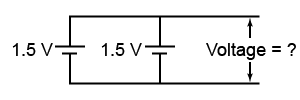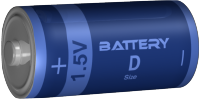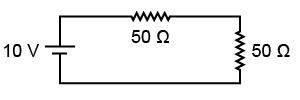
- Two batteries are connected together as shown in the figure. What is the value of the voltage across them?
- 0 V
- 0.75 V
- 1.5 V
- 3 V
- Which statement or statements below provide a correct practical definition of a voltage source?
- A voltage source creates an electric potential difference between two points in a circuit, such as the two ends of a battery.
- A voltage source provides the electrical potential energy needed for a circuit to operate.
- A voltage source is analogous to the pump in a system of circulating water.
- All of the above
- Which of the following is not a good electrical insulator?
- wood
- air
- water
- plastic
- What is the correct relationship among current, resistance, and voltage?
- Current is directly proportional to resistance and voltage.
- Current is directly proportional to resistance and inversely proportional to voltage.
- Current is inversely proportional to resistance and directly proportional to voltage.
- Current is inversely proportional to both resistance and voltage.

- What does the label “1.5 V” on the battery mean?
- The voltage of the positive terminal is 1.5 V.
- The voltage of the negative terminal is 0 V.
- The potential difference between the two terminals is 1.5 V.
- All of the above
| | - A circuit consists of a battery plus two resistors connected in parallel with each other.
How do you connect the data acquisition probes for a digital multimeter to measure the current through one of the resistors?
- in parallel across the resistor
- in series with the resistor
- in parallel across the battery
- in series with the battery

- What is the current through the circuit shown?
- 0.1 A
- 0.4 A
- 1 A
- 4 A
- A mobile phone charger draws 0.2 A of current from the 120 V wall outlet. How much energy does it use if it were plugged in for 24 hours?
- 0.024 kWh
- 0.58 kWh
- 35 kWh
- 2,070 kWh
- A 50 Ω lamp is connected to a 120 V electrical outlet. How much power is consumed by the lamp?
- 2.4 W
- 20.8 W
- 288 W
- 6,000 W
- Four 1 Ω resistors are connected in parallel across a 10 V battery. What is the equivalent resistance of the circuit?
- 0.1 Ω
- 0.25 Ω
- 4 Ω
- 10 Ω
- Which of the following can be done with data acquisition probes and a digital multimeter?
- Voltage can be measured.
- Power can be measured.
- Continuity can be tested.
- I only
- I and II only
- I and III only
- I, II, and III
|

